Asus RT-N12E C1, RT-N300 B1 User’s Manual
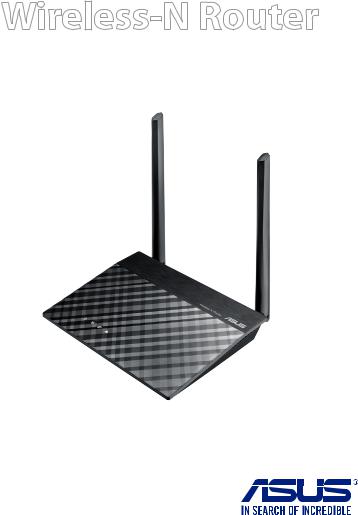
User Guide
Wireless-N Router

E12363
First Edition
January 2017
Copyright © 2017 ASUSTeK Computer Inc. All Rights Reserved.
No part of this manual, including the products and software described in it, may be reproduced, transmitted, transcribed, stored in a retrieval
system, or translated into any language in any form or by any means, except documentation kept by the purchaser for backup purposes, without the express written permission of ASUSTeK Computer Inc. (“ASUS”).
Product warranty or service will not be extended if: (1) the product is repaired, modified or altered, unless such repair, modification of alteration is authorized in writing by ASUS; or (2) the serial number of the product is defaced or missing.
ASUS PROVIDES THIS MANUAL “AS IS”WITHOUT WARRANTY OF ANY KIND, EITHER EXPRESS OR IMPLIED, INCLUDING BUT NOT LIMITED TO THE IMPLIED WARRANTIES OR CONDITIONS OF MERCHANTABILITY OR FITNESS FOR A PARTICULAR PURPOSE. IN NO EVENT SHALL ASUS, ITS DIRECTORS, OFFICERS, EMPLOYEES OR AGENTS BE LIABLE FOR ANY INDIRECT, SPECIAL, INCIDENTAL, OR CONSEQUENTIAL DAMAGES (INCLUDING DAMAGES FOR LOSS OF PROFITS, LOSS OF BUSINESS, LOSS OF USE OR DATA, INTERRUPTION OF BUSINESS
AND THE LIKE), EVEN IF ASUS HAS BEEN ADVISED OF THE POSSIBILITY OF SUCH DAMAGES ARISING FROM ANY DEFECT OR ERROR IN THIS MANUAL OR PRODUCT.
SPECIFICATIONS AND INFORMATION CONTAINED IN THIS MANUAL ARE FURNISHED FOR INFORMATIONAL USE ONLY, AND ARE SUBJECT TO CHANGE AT ANY TIME WITHOUT NOTICE, AND SHOULD NOT BE CONSTRUED AS A COMMITMENT BY ASUS. ASUS ASSUMES NO RESPONSIBILITY OR LIABILITY FOR ANY ERRORS OR INACCURACIES THAT MAY APPEAR IN THIS MANUAL, INCLUDING THE PRODUCTS AND SOFTWARE DESCRIBED IN IT.
Products and corporate names appearing in this manual may or may not be registered trademarks or copyrights of their respective companies, and are used only for identification or explanation and to the owners’ benefit, without intent to infringe.
2

Table of contents
1 |
Getting to know your wireless router |
6 |
|
1.1 |
Package contents.......................................................................... |
6 |
|
1.2 |
Your wireless router..................................................................... |
7 |
|
1.3 |
Positioning your router............................................................ |
10 |
|
1.4 |
Setup Requirements................................................................. |
11 |
|
1.5 |
Router Setup................................................................................ |
12 |
|
|
1.5.1 |
Wired connection.................................................................. |
12 |
|
1.5.2 |
Wireless connection.............................................................. |
13 |
2 |
Getting started |
15 |
2.1 |
Logging into the Web GUI...................................................... |
15 |
2.2 |
Quick Internet Setup (QIS) with Auto-detection............ |
16 |
2.3 |
Connecting to your wireless network................................ |
18 |
3 |
Configuring the General settings |
19 |
3.1 |
Network Map .............................................................................. |
19 |
|
3.1.1 Set up the wireless security............................................... |
20 |
|
3.1.2 Manage your network clients............................................ |
20 |
3.2 |
Create a Guest Network.......................................................... |
21 |
3.3 |
Traffic Manager........................................................................... |
22 |
|
3.3.1 Manage QoS (Quality of Service) Bandwidth.............. |
22 |
|
3.3.2 Traffic Monitor......................................................................... |
23 |
3.4 |
Set up Parental Controls.......................................................... |
24 |
4 |
Configure Advanced Settings |
25 |
|
4.1 |
Wireless......................................................................................... |
25 |
|
|
4.1.1 |
General...................................................................................... |
25 |
|
4.1.2 |
WPS............................................................................................. |
28 |
|
4.1.3 |
WDS............................................................................................ |
30 |
|
4.1.4 |
Wireless MAC Filter................................................................ |
31 |
3

Table of contents
|
4.1.5 |
RADIUS Setting....................................................................... |
32 |
|
4.1.6 |
Professional.............................................................................. |
33 |
4.2 |
LAN.................................................................................................. |
|
35 |
|
4.2.1 |
LAN IP......................................................................................... |
35 |
|
4.2.2 |
DHCP Server............................................................................ |
35 |
|
4.2.3 |
Route.......................................................................................... |
37 |
|
4.2.4 IPTV................................................................................................ |
37 |
|
4.3 |
WAN................................................................................................ |
|
38 |
|
4.3.1 |
Internet Connection............................................................. |
38 |
|
4.3.2 |
Port Trigger.............................................................................. |
40 |
|
4.3.3 |
Virtual Server/Port Forwarding......................................... |
42 |
|
4.3.4 |
DMZ............................................................................................ |
45 |
|
4.3.5 |
DDNS.......................................................................................... |
46 |
|
4.3.6 |
NAT Passthrough.................................................................... |
47 |
4.4 |
IPv6................................................................................................. |
|
48 |
4.5 |
Firewall.......................................................................................... |
49 |
|
|
4.5.1 |
General...................................................................................... |
49 |
|
4.5.2 |
URL Filter................................................................................... |
49 |
|
4.5.3 |
Keyword filter.......................................................................... |
50 |
|
4.5.4 |
Network Services Filter........................................................ |
51 |
4.6 |
IPv6 Firewall................................................................................. |
52 |
|
4.7 |
Administration............................................................................ |
53 |
|
|
4.7.1 |
Operation Mode..................................................................... |
53 |
|
4.7.2 |
System....................................................................................... |
54 |
|
4.7.3 |
Firmware Upgrade................................................................. |
55 |
|
4.7.4 |
Restore/Save/Upload Setting............................................ |
55 |
4

Table of contents |
|
|
4.8 |
System Log................................................................................... |
56 |
5 |
Utilities |
57 |
5.1 |
Device Discovery........................................................................ |
57 |
5.2 |
Firmware Restoration............................................................... |
57 |
6 |
Troubleshooting |
58 |
6.1 |
Basic Troubleshooting.............................................................. |
58 |
6.2 |
Frequently Asked Questions (FAQs) ................................... |
60 |
Appendices |
67 |
|
Notices ....................................................................................................... |
67 |
|
ASUS Contact information..................................................................... |
81 |
|
Networks Global Hotline Information............................................... |
82 |
|
5

1Getting to know your wireless router
1.1 Package contents
Wireless-N Router |
Warranty Card |
Power adapter |
Quick Start Guide |
NOTES:
•If any of the items are damaged or missing, contact ASUS for technical inquiries and support. Refer to the ASUS Support Hotline list at the back of this user manual.
•Keep the original packaging material in case you would need future warranty services such as repair or replacement.
6
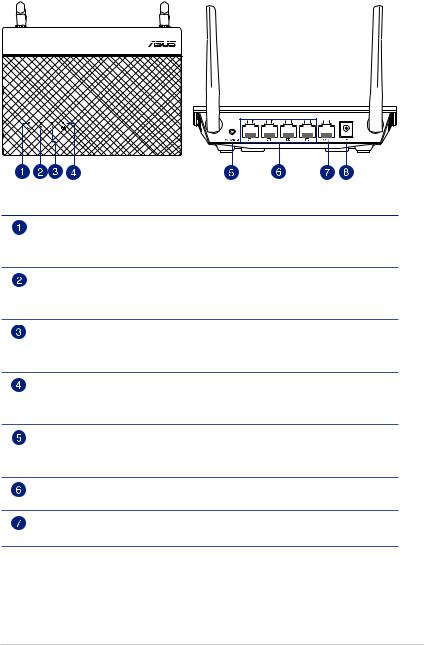
1.2 Your wireless router
Wireless N Router
Power LED
Off: No power.
On: Device is ready.
2.4GHz LED
Off: No 2.4GHz signal.
On:Wireless system is ready.
WAN LED
Off: No power or no physical connection.
On: Has physical connection to a wide area network (WAN).
LAN 1~4 LED
Off: No power or no physical connection.
On: Has physical connection to a local area network (LAN).
WPS / reset button (2-in-1)
This button launches the WPS wizard or resets / restores the system to its factory default settings.
LAN 1 ~ 4 port
Connect network cables into these ports to establish LAN connection.
WAN port
Connect a network cable into this port to establish WAN connection.
7

Power (DC-IN) port
Insert the bundled AC adapter into this port and connect your router to a power source.
NOTES:
•Use only the adapter that came with your package. Using other adapters may damage the device.
•Specifications:
|
DC Power adapter |
DC Output: +19V with max 1.75A current; |
|
||
|
|
|
|
|
|
|
Operating |
0~40oC |
Storage |
0~70oC |
|
|
Temperature |
|
|
|
|
|
Operating Humidity |
50~90% |
Storage |
20~90% |
|
|
|
|
|
|
|
8
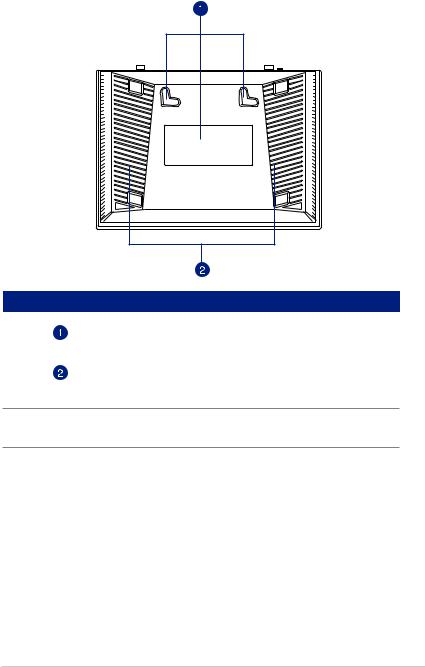
Bottom panel
Item |
Description |
|
|
|
Mounting hooks |
|
Use the mounting hooks to mount your router on concrete |
|
or wooden surfaces using two round head screws. |
|
Air vents |
|
These vents provide ventilation to your router. |
|
|
NOTE: Mounting the wireless router to a wall is not recommended as it reduces wireless performance.
9
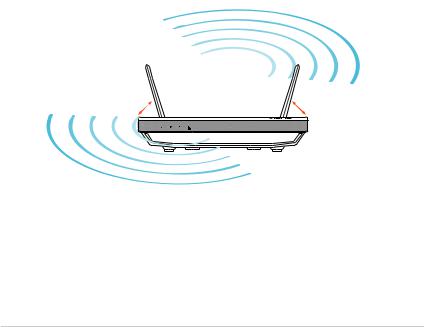
1.3 Positioning your router
For the best wireless signal transmission between the wireless router and the network devices connected to it, ensure that you:
•Place the wireless router in a centralized area for a maximum wireless coverage for the network devices.
•Keep the device away from metal obstructions and away from direct sunlight.
•Keep the device away from 802.11g or 20MHz onlyWi-Fi devices, 2.4GHz computer peripherals, Bluetooth devices, cordless phones,transformers,heavy-duty motors,fluorescent lights, microwave ovens, refrigerators, and other industrial equipment to prevent signal interference or loss.
•Always update to the latest firmware.Visit the ASUS website at http://www.asus.com to get the latest firmware updates.
•To ensure the best wireless signal,orient the three detachable antennas as shown in the drawing below.
45° |
45° |
10

1.4 Setup Requirements
To set up your wireless network, you need a computer that meets the following system requirements:
•Ethernet RJ-45 (LAN) port (10Base-T/100Base-TX/
1000BaseTX)
•IEEE 802.11b/g/n wireless capability
•An installedTCP/IP service
•Web browser such as Internet Explorer, Firefox, Safari, or
Google Chrome
NOTES:
•If your computer does not have built-in wireless capabilities, you may install an IEEE 802.11b/g/n WLAN adapter to your computer to connect to the network.
•If your computer does not have built-in wireless capabilities, you may install a WLAN adapter to your computer to connect to the network.
•The Ethernet RJ-45 cables that will be used to connect the network devices should not exceed 100 meters.
11
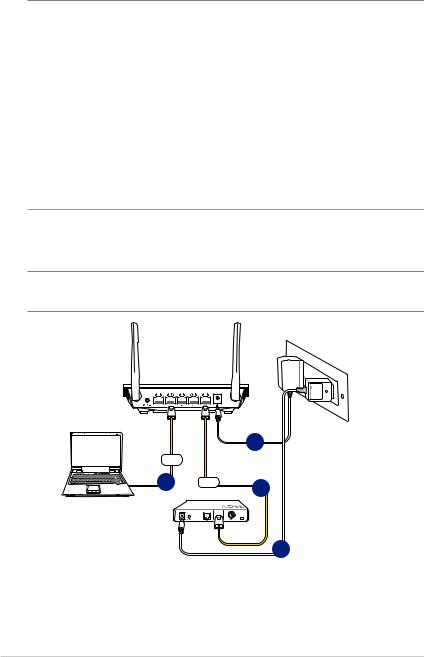
1.5 Router Setup
IMPORTANT!
•Use a wired connection when setting up your wireless router to avoid possible setup problems.
•Before setting up your ASUS wireless router, do the following:
•If you are replacing an existing router, disconnect it from your network.
•Disconnect the cables/wires from your existing modem setup. If your modem has a backup battery, remove it as well.
•Reboot your cable modem and computer (recommended).
1.5.1 Wired connection
NOTE: You can use either a straight-through cable or a crossover cable for wired connection.
Wireless-N Router
1
LAN
2 WAN
3
4
To set up your wireless router via wired connection:
1.Insert your wireless router’s AC adapter to the DC-IN port and plug it to a power outlet.
12
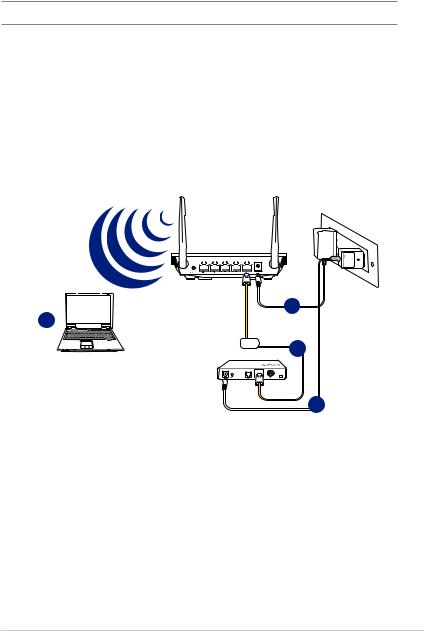
2.Using the bundled network cable, connect your computer to your wireless router’s LAN port.
IMPORTANT! Ensure that the LAN LED is blinking.
3Using another network cable, connect your modem to your wireless router’s WAN port.
4.Insert your modem’s AC adapter to the DC-IN port and plug it to a power outlet.
1.5.2 Wireless connection
Wireless-N Router
4
WAN 2
3
To set up your wireless router via wireless connection:
1.Insert your wireless router’s AC adapter to the DC-IN port and plug it to a power outlet.
2Using the bundled network cable, connect your modem to your wireless router’s WAN port.
13

3.Insert your modem’s AC adapter to the DC-IN port and plug it to a power outlet.
4.Install an IEEE 802.11b/g/n WLAN adapter on your computer.
NOTES:
•For details on connecting to a wireless network, refer to the WLAN adapter’s user manual.
•To set up the security settings for your network, refer to the section
Setting up the wireless security settings in Chapter 3 of this user manual.
14

2 Getting started
2.1 Logging into the Web GUI
Your ASUS Wireless Router comes with an intuitive web graphical user interface (GUI) that allows you to easily configure its various features through a web browser such as Internet Explorer, Firefox, Safari, or Google Chrome.
NOTE: The features may vary with different firmware versions.
To log into the web GUI:
1.On your web browser, enter http://router.asus.com.
2.On the login page, key in the default user name (admin) and password (admin).
3.You can now use the Web GUI to configure various settings of your ASUS Wireless Router.
NOTE: If you are logging into the Web GUI for the first time, you will be directed to the Quick Internet Setup (QIS) page automatically.
15

2.2Quick Internet Setup (QIS) with Autodetection
The Quick Internet Setup (QIS) function guides you in quickly setting up your Internet connection.
NOTES:
•When setting the Internet connection for the first time, press the reset button on your wireless router to reset it to its factory default settings.
•By default, the login username and password for your wireless router's Web GUI is admin. For details on changing your wireless router's login username and password, refer to section 4.7.2 System.
•The wireless router's login username and password allows you to log into your wireless router's Web GUI to configure your wireless router's settings.
1.The wireless router automatically detects if your ISP connection type is Dynamic IP, PPPoE, PPTP, L2TP, and Static IP. Key in the necessary information for your ISP connection type.
IMPORTANT! Obtain the necessary information from your ISP about the Internet connection type.
NOTES:
•The auto-detection of your ISP connection type takes place when you configure the wireless router for the first time or when your wireless router is reset to its default settings.
•If QIS failed to detect your Internet connection type, click Manual setting and manually configure your connection settings.
2.Assign the wireless network name (SSID) and security key for your 2.4GHz wireless connection.
16

3.Your Internet and wireless settings are displayed.
4.Read the wireless network connection tutorial.
17

2.3 Connecting to your wireless network
After setting up your wireless router via QIS, you can connect your computer or other smart devices to your wireless network.
To connect to your network:
1.On your computer, select the wireless network you want to connect to.
2.Wait while your computer establishes connection to the wireless network successfully.
NOTE: Refer to the next chapters for more details on configuring your wireless network's settings.
18
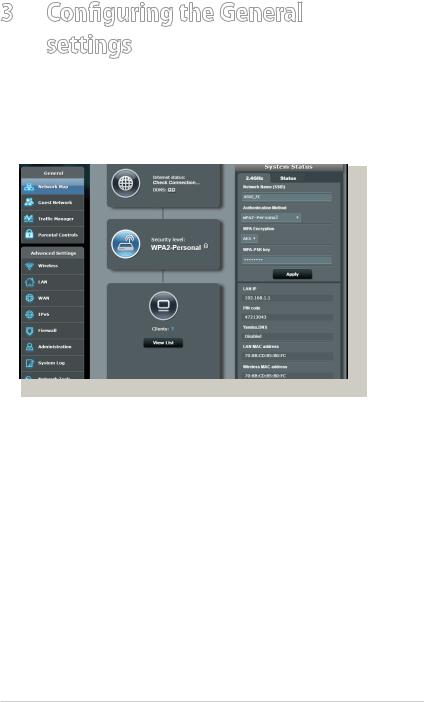
3Configuring the General settings
3.1 Network Map
Network Map allows you to configure your network’s security settings, manage your network clients.
19

3.1.1 Set up the wireless security
To protect your wireless network from unauthorized access, you need to configure its security settings.
To set up the wireless security settings:
1.From the navigation panel, go to General > Network Map.
2.On the Network Map screen and under System Status, you can configure the wireless security settings such as SSID, security level, and encryption settings.
3. On the Network Name (SSID) field, key in a unique name for your wireless network.
4.From the Authentication Method dropdown list, select the encryption method for your wireless network.
IMPORTANT! The IEEE 802.11n/ac standard prohibits using High Throughput with WEP or WPA-TKIP as the unicast cipher. If you use these encryption methods, your data rate will drop to IEEE 802.11g 54Mbps connection.
5. Key in your security passkey.
6. Click Apply when done.
3.1.2 Manage your network clients
To manage your network clients:
1. From the navigation panel, go to General > Network Map tab.
2. On the Network Map screen,select the Client icon to display your network client’s information.
20
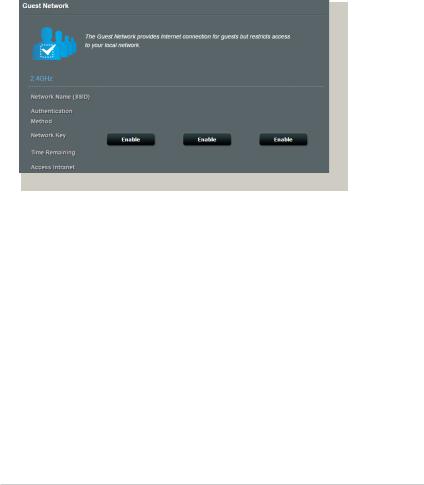
3.2 Create a Guest Network
The Guest Network provides temporary visitors with Internet connectivity via access to separate SSIDs or networks without providing access to your private network.
To create a guest network:
1.From the navigation panel, go to General > Guest Network.
2.Click Enable.
3.Assign a wireless name (SSID) for your temporary network, select an authentication method and finish other settings. When done, click Apply.
21

3.3 Traffic Manager
3.3.1 Manage QoS (Quality of Service) Bandwidth
Quality of Service (QoS) allows you to set the bandwidth priority and manage network traffic.
To set up bandwidth priority:
1.From the navigation panel, go to General > Traffic Manager > QoS tab.
2.Click ON to enable QoS. Fill in the upload and download bandwidth fields.
NOTE: Get the bandwidth information from your ISP.
3. Click Apply.
22
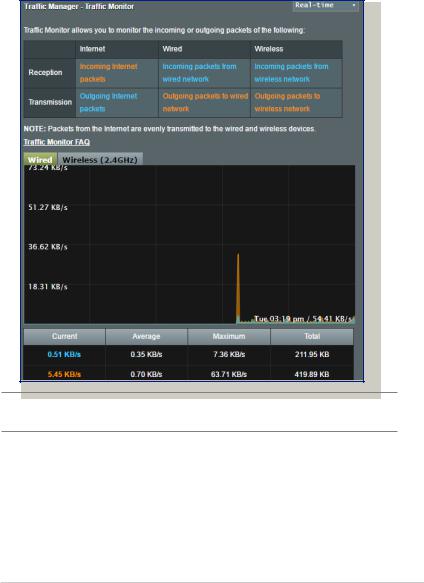
3.3.2 Traffic Monitor
The traffic monitor function allows you to access the bandwidth usage and speed of your Internet, wired, and wireless networks. It allows you to monitor network traffic even on a daily basis.
NOTE: Packets from the Internet are evenly transmitted to the wired and wireless devices.
23
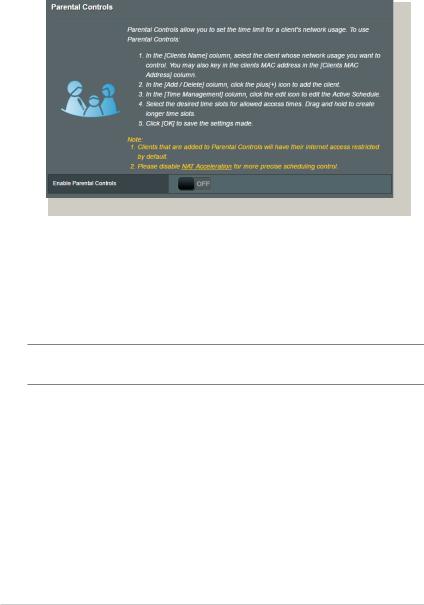
3.4 Set up Parental Controls
Parental Controls allow you to control the Internet access time. Users can set the time limit for a client’s network usage.
To use the parental control function:
1.From the navigation panel, go to General > Parental Controls.
2.Click ON to enable Parental Controls.
3.Select the client whose network usage you want to control. You may also key in the client’s MAC address.
NOTE: Ensure that the client name does not contain special characters or spaces as this may cause the router to function abnormally.
4.You can add or delete the client’s profile.
5.Set up the allowed time limit in Time Management map.
6.Click Apply to save the settings.
24
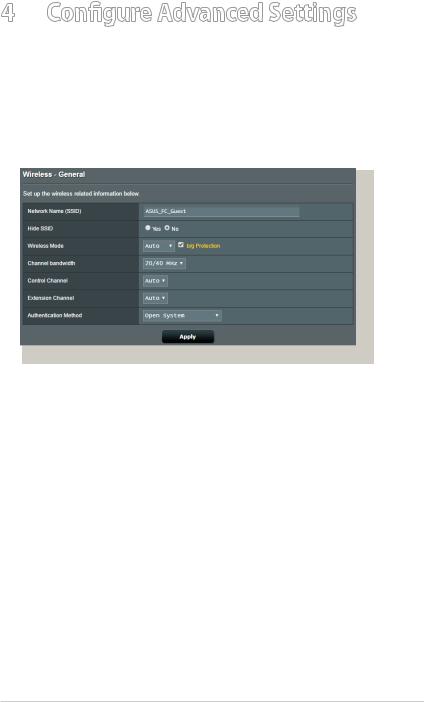
4 Configure Advanced Settings
4.1 Wireless
4.1.1 General
The General tab allows you to configure the basic wireless settings.
To configure basic wireless settings:
1.From the navigation panel, go to Advanced Settings >
Wireless > General tab.
2.Assign a unique name containing up to 32 characters for your SSID (Service Set Identifier) or network name to identify your wireless network. Wi-Fi devices can identify and connect to the wireless network via your assigned SSID. The SSIDs on the information banner are updated once new SSIDs are saved to the settings.
25

3.In the Hide SSID field, select Yes to prevent wireless devices from detecting your SSID. When this function is enabled, you would need to enter the SSID manually on the wireless device to access the wireless network.
4.Select any of these wireless mode options to determine the types of wireless devices that can connect to your wireless router:
•Auto: Select Auto to allow 802.11n, 802.11g, and 802.11b devices to connect to the wireless router.
•N only: Select N only to maximize wireless N performance. This setting prevents 802.11g and 802.11b devices from connecting to the wireless router.
•Legacy: Select Legacy to allow 802.11b/g/n devices to connect to the wireless router. Hardware that supports 802.11n natively, however, will only run at a maximum speed of 54Mbps.
5.Select any of these channel bandwidth to accommodate higher transmission speeds:
20/40MHz (default): Select this bandwidth to automatically select the best bandwidth for your wireless environment.
20MHz: Select this bandwidth if you encounter some issues with your wireless connection.
40MHz: Select this bandwidth to maximize the wireless throughput.
6.Select the operating channel for your wireless router. Select Auto to allow the wireless router to automatically select the channel that has the least amount of interference.
7.If 20/40MHz, 20MHz or 40MHz is selected, you can define an upper or lower adjacent channel in the Extension Channel field to be accommodated.
8.Select any of these authentication methods:
•Open System: This option provides no security.
26
